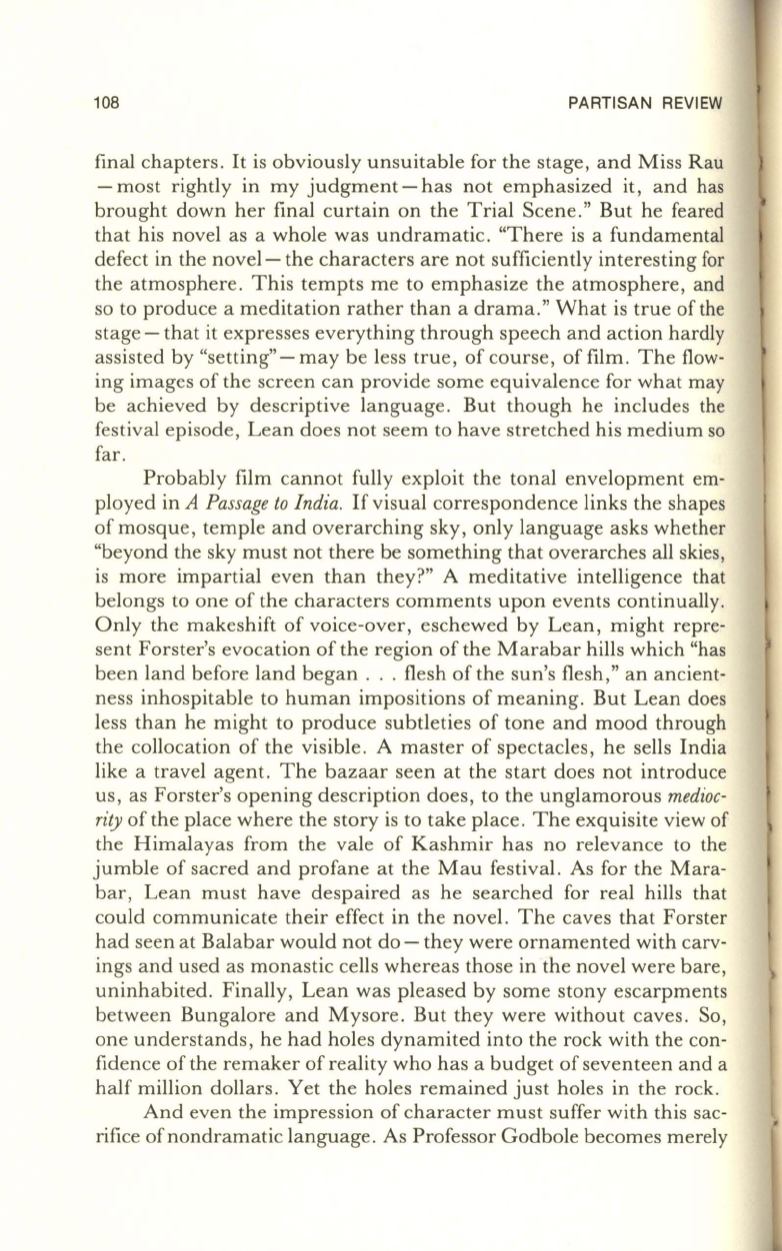
108
PARTISAN REVIEW
final chapters. It is obviously unsuitable for the stage, and Miss Rau
- most rightly in my judgment - has not emphasized it, and has
brought down her final curtain on the Trial Scene." But he feared
that his novel as a whole was undramatic. "There is a fundamental
defect in the novel- the characters are not sufficiently interesting for
the atmosphere . This tempts me to emphasize the atmosphere, and
so to produce a meditation rather than a drama." What is true of the
stage - that it expresses everything through speech and action hardly
assisted by "setting" - may be less true, of course, of film . The flow–
ing images of the screen can provide some equivalence for what may
be achieved by descriptive language. But though he includes the
festival episode, Lean does not seem to have stretched his medium so
far.
Probably film cannot fully exploit the tonal envelopment em–
ployed in
A Passage to India .
If
visual correspondence links the shapes
of mosque, temple and overarching sky, only language asks whether
"beyond the sky must not there be something that overarches all skies,
is more impartial even than they?" A meditative intelligence that
belongs to one of the characters comments upon events continually.
Only the makeshift of voice-over, eschewed by Lean, might repre–
sent Forster's evocation of the region of the Marabar hills which "has
been land before land began ... flesh of the sun's flesh," an ancient–
ness inhospitable to human impositions of meaning. But Lean does
less than he might to produce subtleties of tone and mood through
the collocation of the visible . A master of spectacles, he sells India
like a travel agent. The bazaar seen at the start does not introduce
us, as Forster's opening description does, to the unglamorous
medioc–
rity
of the place where the story is to take place. The exquisite view of
the Himalayas from the vale of Kashmir has no relevance to the
jumble of sacred and profane at the Mau festival. As for the Mara–
bar, Lean must have despaired as he searched for real hills that
could communicate their effect in the novel. The caves that Forster
had seen at Balabar would not do - they were ornamented with carv–
ings and used as monastic cells whereas those in the novel were bare,
uninhabited . Finally, Lean was pleased by some stony escarpments
between Bungalore and Mysore. But they were without caves. So,
one understands, he had holes dynamited into the rock with the con–
fidence of the remaker of reality who has a budget of seventeen and a
half million dollars . Yet the holes remained just holes in the rock.
And even the impression of character must suffer with this sac–
rifice of nondramatic language. As Professor Godbole becomes merely


